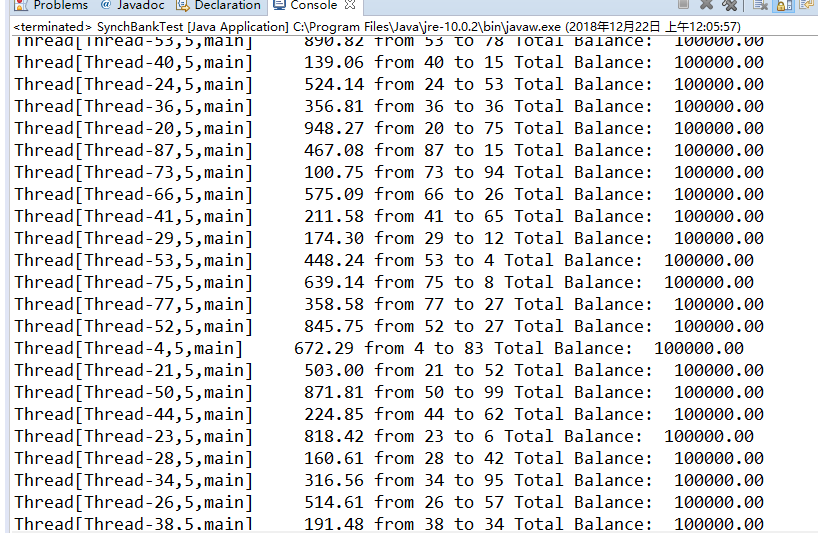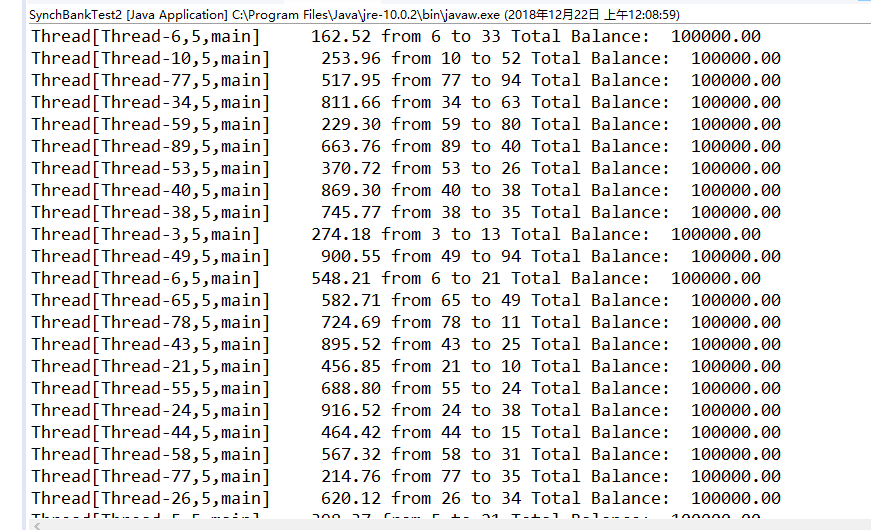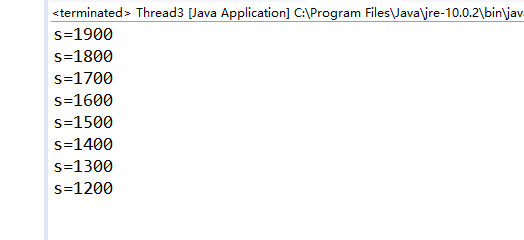王艳 201771010127《面向对象程序设计(java)》第十七周学习总结
实验十七 线程同步控制
实验时间 2018-12-10
一、理论部分
1.线程同步:多线程并发运行不确定性问题解决方案:引入线程同步机制,使得另一线程要使用该方法,就只能等待。
解决方案:
1)锁对象与条件对象
有关锁对象和条件对象的关键要点:
➢ 锁用来保护代码片段,保证任何时刻只能有一个线程执行被保护的代码。
➢ 锁管理试图进入被保护代码段的线程。
➢ 锁可拥有一个或多个相关条件对象。
➢ 每个条件对象管理那些已经进入被保护的代码段但还不能运行的线程。
2)synchronized关键字
某个类内方法用synchronized 修饰后,该方法被称为同步方法;
只要某个线程正在访问同步方法,其他线程欲要访问同步方法就被阻塞,直至线程从同步方法返回前唤醒被阻塞线程,其他线程方可能进入同步方法。
一个线程在使用的同步方法中时,可能根据问题的需要,必须使用wait()方法使本线程等待,暂时让出CPU的使用权,并允许其它线程使用这个同步方法。
线程如果用完同步方法,应当执行notifyAll()方法通知所有由于使用这个同步方法而处于等待的线程结束等待。
二、实验部分
1、实验目的与要求
(1) 掌握线程同步的概念及实现技术;
(2) 线程综合编程练习
2、实验内容和步骤
实验1:测试程序并进行代码注释。
测试程序1:
l 在Elipse环境下调试教材651页程序14-7,结合程序运行结果理解程序;
掌握利用锁对象和条件对象实现的多线程同步技术。
程序如下:
package test2; /**
* This program shows how multiple threads can safely access a data structure.
* @version 1.31 2015-06-21
* @author Cay Horstmann
*/
public class SynchBankTest
{
public static final int NACCOUNTS = ;
public static final double INITIAL_BALANCE = ;
public static final double MAX_AMOUNT = ;
public static final int DELAY = ; public static void main(String[] args)
{
Bank bank = new Bank(NACCOUNTS, INITIAL_BALANCE);
for (int i = ; i < NACCOUNTS; i++)
{
int fromAccount = i;
Runnable r = () -> {
try
{
while (true)
{
int toAccount = (int) (bank.size() * Math.random());
double amount = MAX_AMOUNT * Math.random();
bank.transfer(fromAccount, toAccount, amount);
Thread.sleep((int) (DELAY * Math.random()));
}
}
catch (InterruptedException e)
{
}
};
Thread t = new Thread(r);
t.start();
}
}
}
package test2; import java.util.*;
import java.util.concurrent.locks.*; /**
* A bank with a number of bank accounts that uses locks for serializing access.
* @version 1.30 2004-08-01
* @author Cay Horstmann
*/
public class Bank
{
private final double[] accounts;
private Lock bankLock;
private Condition sufficientFunds; /**
* Constructs the bank.
* @param n the number of accounts
* @param initialBalance the initial balance for each account
*/
public Bank(int n, double initialBalance)
{
accounts = new double[n];
Arrays.fill(accounts, initialBalance);
bankLock = new ReentrantLock();
sufficientFunds = bankLock.newCondition();
} /**
* Transfers money from one account to another.
* @param from the account to transfer from
* @param to the account to transfer to
* @param amount the amount to transfer
*/
public void transfer(int from, int to, double amount) throws InterruptedException
{
bankLock.lock();
try
{
while (accounts[from] < amount)
sufficientFunds.await();
System.out.print(Thread.currentThread());
accounts[from] -= amount;
System.out.printf(" %10.2f from %d to %d", amount, from, to);
accounts[to] += amount;
System.out.printf(" Total Balance: %10.2f%n", getTotalBalance());
sufficientFunds.signalAll();
}
finally
{
bankLock.unlock();
}
} /**
* Gets the sum of all account balances.
* @return the total balance
*/
public double getTotalBalance()
{
bankLock.lock();
try
{
double sum = ; for (double a : accounts)
sum += a; return sum;
}
finally
{
bankLock.unlock();
}
} /**
* Gets the number of accounts in the bank.
* @return the number of accounts
*/
public int size()
{
return accounts.length;
}
}
程序运行结果如下:

测试程序2:
l 在Elipse环境下调试教材655页程序14-8,结合程序运行结果理解程序;
l 掌握synchronized在多线程同步中的应用。
程序如下:
package test2; /**
* This program shows how multiple threads can safely access a data structure,
* using synchronized methods.
* @version 1.31 2015-06-21
* @author Cay Horstmann
*/
public class SynchBankTest2
{
public static final int NACCOUNTS = ;
public static final double INITIAL_BALANCE = ;
public static final double MAX_AMOUNT = ;
public static final int DELAY = ; public static void main(String[] args)
{
Bank bank = new Bank(NACCOUNTS, INITIAL_BALANCE);
for (int i = ; i < NACCOUNTS; i++)
{
int fromAccount = i;
Runnable r = () -> {
try
{
while (true)
{
int toAccount = (int) (bank.size() * Math.random());
double amount = MAX_AMOUNT * Math.random();
bank.transfer(fromAccount, toAccount, amount);
Thread.sleep((int) (DELAY * Math.random()));
}
}
catch (InterruptedException e)
{
}
};
Thread t = new Thread(r);
t.start();
}
}
}
package test2; import java.util.*;
import java.util.concurrent.locks.*; /**
* A bank with a number of bank accounts that uses locks for serializing access.
* @version 1.30 2004-08-01
* @author Cay Horstmann
*/
public class Bank
{
private final double[] accounts;
private Lock bankLock;
private Condition sufficientFunds; /**
* Constructs the bank.
* @param n the number of accounts
* @param initialBalance the initial balance for each account
*/
public Bank(int n, double initialBalance)
{
accounts = new double[n];
Arrays.fill(accounts, initialBalance);
bankLock = new ReentrantLock();
sufficientFunds = bankLock.newCondition();
} /**
* Transfers money from one account to another.
* @param from the account to transfer from
* @param to the account to transfer to
* @param amount the amount to transfer
*/
public void transfer(int from, int to, double amount) throws InterruptedException
{
bankLock.lock();
try
{
while (accounts[from] < amount)
sufficientFunds.await();
System.out.print(Thread.currentThread());
accounts[from] -= amount;
System.out.printf(" %10.2f from %d to %d", amount, from, to);
accounts[to] += amount;
System.out.printf(" Total Balance: %10.2f%n", getTotalBalance());
sufficientFunds.signalAll();
}
finally
{
bankLock.unlock();
}
} /**
* Gets the sum of all account balances.
* @return the total balance
*/
public double getTotalBalance()
{
bankLock.lock();
try
{
double sum = ; for (double a : accounts)
sum += a; return sum;
}
finally
{
bankLock.unlock();
}
} /**
* Gets the number of accounts in the bank.
* @return the number of accounts
*/
public int size()
{
return accounts.length;
}
}
程序运行结果:

测试程序3:
l 在Elipse环境下运行以下程序,结合程序运行结果分析程序存在问题;
l 尝试解决程序中存在问题。
package test2;
class Cbank
{
private static int s=;
public static void sub(int m)
{
int temp=s;
temp=temp-m;
try {
Thread.sleep((int)(*Math.random()));
}
catch (InterruptedException e) { }
s=temp;
System.out.println("s="+s);
}
} class Customer extends Thread
{
public void run()
{
for( int i=; i<=; i++)
Cbank.sub();
}
}
public class Thread3
{
public static void main(String args[])
{
Customer customer1 = new Customer();
Customer customer2 = new Customer();
customer1.start();
customer2.start();
}
}
程序运行后如图:

分析程序,输出结果应为1900—1200,而控制台上显示结果有重复。因为没有对程序加上锁功能。修改后程序如下:
package test2;
class Cbank
{
private static int s=;
public synchronized static void sub(int m)
{
int temp=s;
temp=temp-m;
try {
Thread.sleep((int)(*Math.random()));
}
catch (InterruptedException e) { }
s=temp;
System.out.println("s="+s);
}
} class Customer extends Thread
{
public void run()
{
for( int i=; i<=; i++)
Cbank.sub();
}
}
public class Thread3
{
public static void main(String args[])
{
Customer customer1 = new Customer();
Customer customer2 = new Customer();
customer1.start();
customer2.start();
}
}
程序运行结果如下:

实验2 编程练习
利用多线程及同步方法,编写一个程序模拟火车票售票系统,共3个窗口,卖10张票,程序输出结果类似(程序输出不唯一,可以是其他类似结果)。
Thread-0窗口售:第1张票
Thread-0窗口售:第2张票
Thread-1窗口售:第3张票
Thread-2窗口售:第4张票
Thread-2窗口售:第5张票
Thread-1窗口售:第6张票
Thread-0窗口售:第7张票
Thread-2窗口售:第8张票
Thread-1窗口售:第9张票
Thread-0窗口售:第10张票
程序如下:
package test2;
public class Demo {
public static void main(String[] args) {
Mythread mythread = new Mythread();
Thread ticket1 = new Thread(mythread);
Thread ticket2 = new Thread(mythread);
Thread ticket3 = new Thread(mythread);
ticket1.start();
ticket2.start();
ticket3.start();
}
}
class Mythread implements Runnable {
int ticket = ;
boolean flag = true;
@Override
public void run() {
while (flag) {
try {
Thread.sleep();
} catch (InterruptedException e) {
// TODO Auto-generated catch block
e.printStackTrace();
}
synchronized (this) {
if (ticket <= ) {
System.out.println(Thread.currentThread().getName() + "窗口售:第" + ticket + "张票");
ticket++;
}
if (ticket > ) {
flag = false;
}
}
}
}
}
程序运行结果如下:

三:实验总结
这周继续学习了有关线程的知识,主要学习了有关线程同步的问题。线程同步主要是为了解决多线程并发运行不确定性问题,使得多个线程中在一个线程使用某种方法时候,另一线程要使用该方法,就只能等待。实验课上,老师和学长通过演示具体的例子给我们展现了多线程中在不加锁时会出现的情况,让我们对线程同步有了更加清晰地认识。虽然很多地方还是不太懂还是存在很大的问题,但是实验课上讲的内容听得比较清晰,课后自己再运行试验时也有了更深的体会。
王艳 201771010127《面向对象程序设计(java)》第十七周学习总结的更多相关文章
- 201771010134杨其菊《面向对象程序设计java》第九周学习总结
第九周学习总结 第一部分:理论知识 异常.断言和调试.日志 1.捕获 ...
- 扎西平措 201571030332《面向对象程序设计 Java 》第一周学习总结
<面向对象程序设计(java)>第一周学习总结 正文开头: 项目 内容 这个作业属于哪个课程 https://www.cnblogs.com/nwnu-daizh/ 这个作业的要求在哪里 ...
- 201871010132-张潇潇《面向对象程序设计(java)》第一周学习总结
面向对象程序设计(Java) 博文正文开头 项目 内容 这个作业属于哪个课程 https://www.cnblogs.com/nwnu-daizh/ 这个作业的要求在哪里 https://www.cn ...
- 杨其菊201771010134《面向对象程序设计Java》第二周学习总结
第三章 Java基本程序设计结构 第一部分:(理论知识部分) 本章主要学习:基本内容:数据类型:变量:运算符:类型转换,字符串,输入输出,控制流程,大数值以及数组. 1.基本概念: 1)标识符:由字母 ...
- 201871010124 王生涛《面向对象程序设计JAVA》第一周学习总结
项目 内容 这个作业属于哪个课程 https://www.cnblogs.com/nwnu-daizh/ 这个作业的要求在哪里 https://edu.cnblogs.com/campus/xbsf/ ...
- 201871010115——马北《面向对象程序设计JAVA》第二周学习总结
项目 内容 这个作业属于哪个课程 https://www.cnblogs.com/nwnu-daizh/ 这个作业的要求在哪里 https://www.cnblogs.com/nwnu-daizh/p ...
- 201777010217-金云馨《面向对象程序设计(Java)》第二周学习总结
项目 内容 这个作业属于哪个课程 https://www.cnblogs.com/nwnu-daizh/ 这个作业的要求在哪里 https://www.cnblogs.com/nwnu-daizh/p ...
- 201871010132——张潇潇《面向对象程序设计JAVA》第二周学习总结
项目 内容 这个作业属于哪个课程 https://www.cnblogs.com/nwnu-daizh/ 这个作业的要求在哪里 https://www.cnblogs.com/nwnu-daizh/p ...
- 201771010123汪慧和《面向对象程序设计Java》第二周学习总结
一.理论知识部分 1.标识符由字母.下划线.美元符号和数字组成, 且第一个符号不能为数字.标识符可用作: 类名.变量名.方法名.数组名.文件名等.第二部分:理论知识学习部分 2.关键字就是Java语言 ...
- 马凯军201771010116《面向对象与程序设计Java》第九周学习总结
一.理论知识部分 异常.日志.断言和调试 1.异常:在程序的执行过程中所发生的异常事件,它中断指令的正常执行. 2.Java的异常处理机制可以控制程序从错误产生的位置转移到能够进行错误处理的位置. 3 ...
随机推荐
- LeetCode7-ReverseInteger
LeetCode7-ReverseInteger LeetCodeeasyOverflow 题目 题目所在链接为 LeetCode-7:ReverseInteger 题目描述 给出一个32位的有符号整 ...
- 2018/12/08 L1-036 A乘以B Java
简单的题目, 就是考察简单的输入和乘法: import java.io.BufferedReader; import java.io.InputStreamReader; public class M ...
- 蘑菇街CEO陈琪上市致辞:科技是生产力 美丽也是生产力
雷帝网 乐天 12月7日报道 蘑菇街CEO陈琪今日在纽交所上市致辞时表示,蘑菇街的使命是让时尚触手可及,立志成为最领先的时尚目的地,并把"科技是生产力,美丽也是生产力"作为蘑菇街价 ...
- ACM思维题训练 Section A
题目地址: 选题为入门的Codeforce div2/div1的C题和D题. 题解: A:CF思维联系–CodeForces -214C (拓扑排序+思维+贪心) B:CF–思维练习-- CodeFo ...
- 疯子的算法总结(六) 复杂排序算法 ① 归并排序 merge_sort()
归并排序采取了分治的思想,每次分别排左半边和右半边,不断递归调用自己,直到只有一个元素递归结束,开始回溯,调用merge函数,合并两个有序序列,再合并的时候每次给末尾追上一个最大int这样就不怕最后一 ...
- Jenkins 构建 Jmeter 项目之源代码管理(SVN)
1.查看项目创建中是否又 svn 插件,没有的话下载插件 subversion 2.配置 svn 源代码管理,如下图(testcases 目录下包含 build.xml 和脚本文件) 3.查看 Jen ...
- swupdate 之 readback handler
背景 使用 swupdate 作为 OTA 方案 ,有项目要求在写入数据到分区之后需要再次读出校验. 初步实现:readout-verify attribute 初步分析有两种方式 方案一 在每一笔数 ...
- 关于【MySQL 子查询——查询最大值】的补充说明
昨天在使用子查询查找最高分和最低分时遇上了一点问题,情况是这样的:如果找到的最高分或最低分是唯一值则不会有什么问题,但如果有其它班级学生的成绩恰好与查询的最高分或最低分相同时就会把那个学生的信息也显示 ...
- 解决Vue中文本输入框v-model双向绑定后数据不显示的问题
前言 项目中遇到一个问题就是在Vue中双向绑定对象属性时,手动赋值属性后输入框的数据不实时更新的问题. <FormItem label="地址" prop="eve ...
- 用Redislive监控redis
注意:RedisLive是使用Python2.x编写,建议使用2.7,本次环境为Centos 7.2,默认Python版本2.7. 项目地址:https://github.com/nkrode/Red ...
